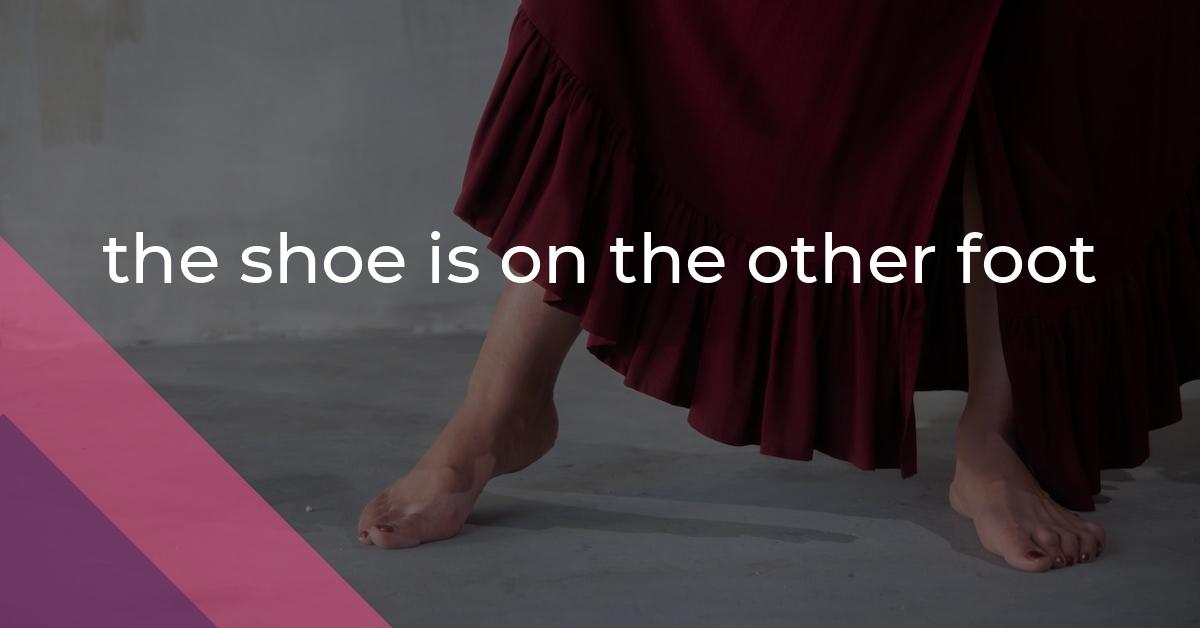the shoe is on the other foot: Idiom Meaning and Origin
What does ‘the shoe is on the other foot’ mean?
When "the shoe is on the other foot," it means that the roles or situations have reversed, with the person who was originally in a position of advantage or control now experiencing the opposite. This idiom highlights a shift in power dynamics or circumstances.

Idiom Explorer
The idiom "which foot the shoe is on" means determining who is responsible or to whom a particular situation or problem belongs.
The idiom "two sides of the same coin" means that two things appear different, but are actually closely related or connected.
When something is turned upside down, it means that its normal position or state has been completely reversed or changed.
The idiom "turn the tide" means to change the course or direction of a situation, typically in a positive way, especially when it seemed to be going against someone or something.
The idiom "turn the tables" means to reverse a situation or gain an advantage over someone who had previously had the upper hand.
The idiom "turn the scale" means to tip the balance or create a decisive change in a situation, typically in someone's favor.
The idiom "turn the other cheek" means to respond to an insult or injury with non-violent resistance or forgiveness, rather than seeking revenge or retaliation.
The idiom "turn over" means to flip or rotate something, or to change one's position or occupation.
The idiom "turn on one's heel" means to abruptly and decisively change direction, often in a gesture of annoyance or indignation.
Roles Reverse
The idiom "the shoe is on the other foot" is used to describe a situation where the roles or circumstances have reversed. It implies that the person who was once in a position of power or advantage is now experiencing the opposite. This idiomatic expression is often used to highlight a shift in power dynamics or to emphasize a change in perspective.
The phrase originated in the early 19th century and has its roots in the idea of swapping shoes. It suggests that one person is now walking in the shoes of the other, experiencing what they had previously experienced.
In its literal sense, the idiom refers to wearing someone else's shoes, symbolizing stepping into their position or understanding their viewpoint. It emphasizes seeing things from a different perspective and gaining a new understanding of a situation.
In a figurative sense, the idiom conveys a similar concept. It implies a change in roles, where the previously advantaged individual now finds themselves in a disadvantaged position, and vice versa. This reversal can occur in various contexts, such as in relationships, politics, or professional settings.
For example, in a workplace scenario, if an employee who was once belittled by their boss gets promoted and becomes the boss themselves, they may use the idiom to describe how the power dynamics have now shifted. The previous boss, now an employee, may find themselves at the other end of the ball, being belittled or controlled.
The idiom "which foot the shoe is on" is closely related to "the shoe is on the other foot." It is used to refer to knowing who has the advantage or is in control of a situation. The phrase suggests that depending on which foot the shoe is on, it determines the outcome or direction of events. It adds another layer of understanding to the idiom "the shoe is on the other foot," emphasizing the importance of recognizing shifts in power.
Another related idiom is "turn the tables." This phrase is used to describe a situation in which a person or group reverses a position of disadvantage and gains the advantage. It is often used to describe situations where the underdog rises to power or manages to overcome obstacles. "Turn the tables" resonates with "the shoe is on the other foot" because they both involve a reversal of roles or circumstances.
Overall, the idiom "the shoe is on the other foot" serves as a vivid metaphor to illustrate a reversal of circumstances or perspectives. It allows individuals to convey the idea of experiencing what someone else has gone through, highlighting shifts in power dynamics and changes in roles.
Through the related idioms "which foot the shoe is on" and "turn the tables," the phrase gains additional depth and context. "Which foot the shoe is on" emphasizes the importance of recognizing who holds the advantage or is in control, while "turn the tables" highlights the potential for the underdog to rise to power.
By using these idioms, individuals can express the complexities and nuances of evolving situations, while also recognizing the potential for a cyclical nature of power and perspective.
Example usage
Examples of how the idiom *the shoe is on the other foot* can be used in a sentence:
- After getting promoted to manager, Jim now has to listen to his employees' complaints. It seems like the shoe is on the other foot.
- For years, John used to make fun of his sister's singing. Now that she has become a famous recording artist, it seems that the shoe is on the other foot.
- As a student, Rachel was always ahead of her classmates. However, now that she has started a new school, the shoe is on the other foot, and she struggles to keep up.
More "Inversion" idioms
We missed the mark - nothing found.



